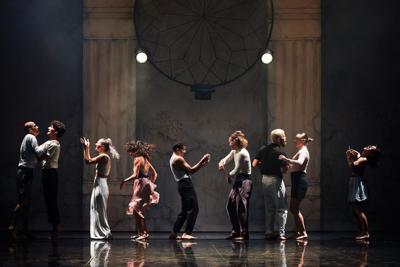At a time when we so often feel disconnected and overwhelmed, the simple act of gathering together can feel revolutionary. And with the U.S. premiere of Compagnie Dyptik’s Le Grand Bal — arriving at OZ Arts this weekend before heading to the prestigious Joyce Theater in New York City — choreographer Mehdi Meghari hopes audiences will feel the power of dance and “the liberation of the body.”
“In our society, we are so isolated — enclosed in our spaces with our phones and computers,” Meghari says, speaking from Dyptik’s home base in Saint-Étienne, France. “It can be an oppressive system, very closed-off. And when we are deprived of certain freedoms and social connections, our bodies need a release. People have a very human need to move, to break free and express themselves. There is something magic in that.”
Meghari first discovered such magic more than 25 years ago, when he and Dyptik co-founder and co-choreographer Souhail Marchiche were drawn to the dynamic, acrobatic elements of breakdance and hip-hop. Together, they worked to perfect their skills, focusing on dance competitions, eventually exploring deeper connections between story, choreography and “the universal language of dance.” The duo established Compagnie Dyptik in 2012, eager to develop new work that would speak to important themes and societal issues.
Le Grand Bal certainly fits that bill. Premiering in 2023, the stunning work draws inspiration from several surprising sources — everything from a visit to a Palestinian refugee camp to the behavior of post-pandemic audiences, and even a mysterious “dancing plague” said to have gripped 16th-century Strasbourg.
“As with most of our work, one project inspires another,” Meghari says. “Our visit to the refugee camp was so interesting because we talked to these children who were having such difficulty. And yet they had so much energy and joy because they were together. They had to walk eight kilometers to school, but they were so happy because they would meet and go together, singing and dancing along the way. It was a great inspiration to us, and so we created a piece called Mirage, which looked at how even when in a most difficult situation, humans can make something good together, something to celebrate.”
Performed outdoors, Mirage offered an immersive experience, with spectators often joining the dancers onstage at the end of the performance. Even when COVID restrictions threatened that communal spirit, Meghari says audiences would not be deterred.
“We were told we could not have the audience join us, but at the end of the show, they all came up anyway,” he says. “We didn’t ask them. It wasn’t part of the script. I just think there was this need to connect, to gather together and dance. We talked a lot about the COVID pandemic and its effects, and that led us to learn about this pandemic in 1518 in Strasbourg. The story tells of a woman who started dancing wildly in the street. It was a desperate time, with famine and disease. The true story is that people, who probably had eaten contaminated grain and were maybe hallucinating, began moving like crazy. More and more joined in, dancing until they collapsed or even died.
“It’s not that we wanted to re-create that actual phenomenon,” Meghari adds. “But we wanted to study the idea behind it — the need for people to gather, to move together, to find that release. And so all of these ideas came together, inspiring us to create a danced fiction where we imagine an old epidemic that has reappeared. Where people are isolated and overwhelmed, and where dance is like a revolution, moving them from deep within.”
The choreographer’s acclaimed performance comes to OZ Arts April 24-26
The result is Le Grand Bal, a darkly fascinating frenzy that gradually overtakes an ensemble of eight remarkable dancers. The performers slowly emerge from the audience, moved by a driving, rhythmic score and dazzling lighting effects. Energy builds, fades and builds again, but the dancers never stop moving. And though quite different in tone than Mirage, Le Grand Bal also captures Dyptik’s unmistakable energy and commitment.
“From the first moment to the last, there is no break,” Meghari says. “The dance moves through them, a physical reaction that goes through many stages and emotions. It is expressive, visceral and liberating dance — a revolution and release.”
As OZ Arts’ executive and artistic director, Mark Murphy sees Le Grand Bal as a perfect start to the organization’s 2025-26 season, a compelling lineup featuring performances and artists from six continents.
“Le Grand Bal is a truly breathtaking, edge-of-your-seat experience,” Murphy says. “It also captures the chaos of this historic, tumultuous moment more than any other art I can think of. These exquisite performers depict people transcending our collective craziness or anxiety with all-out physical release, and even ecstatic joy. Nashville artists will be inspired by the way they transform urban dance forms into a poetic and profound theatrical experience — visually, physically and emotionally. We are truly honored to host the first full-length performance by Compagnie Dyptik on American soil here in Nashville.”






